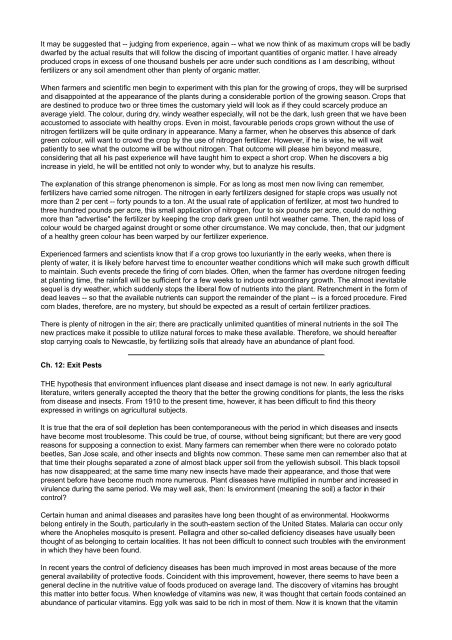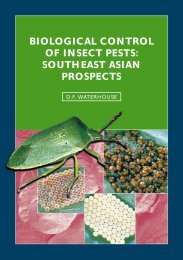Ploughman's Folly Ploughman's Folly - EcoPort
Ploughman's Folly Ploughman's Folly - EcoPort
Ploughman's Folly Ploughman's Folly - EcoPort
Create successful ePaper yourself
Turn your PDF publications into a flip-book with our unique Google optimized e-Paper software.
It may be suggested that -- judging from experience, again -- what we now think of as maximum crops will be badly<br />
dwarfed by the actual results that will follow the discing of important quantities of organic matter. I have already<br />
produced crops in excess of one thousand bushels per acre under such conditions as I am describing, without<br />
fertilizers or any soil amendment other than plenty of organic matter.<br />
When farmers and scientific men begin to experiment with this plan for the growing of crops, they will be surprised<br />
and disappointed at the appearance of the plants during a considerable portion of the growing season. Crops that<br />
are destined to produce two or three times the customary yield will look as if they could scarcely produce an<br />
average yield. The colour, during dry, windy weather especially, will not be the dark, lush green that we have been<br />
accustomed to associate with healthy crops. Even in moist, favourable periods crops grown without the use of<br />
nitrogen fertilizers will be quite ordinary in appearance. Many a farmer, when he observes this absence of dark<br />
green colour, will want to crowd the crop by the use of nitrogen fertilizer. However, if he is wise, he will wait<br />
patiently to see what the outcome will be without nitrogen. That outcome will please him beyond measure,<br />
considering that all his past experience will have taught him to expect a short crop. When he discovers a big<br />
increase in yield, he will be entitled not only to wonder why, but to analyze his results.<br />
The explanation of this strange phenomenon is simple. For as long as most men now living can remember,<br />
fertilizers have carried some nitrogen. The nitrogen in early fertilizers designed for staple crops was usually not<br />
more than 2 per cent -- forty pounds to a ton. At the usual rate of application of fertilizer, at most two hundred to<br />
three hundred pounds per acre, this small application of nitrogen, four to six pounds per acre, could do nothing<br />
more than "advertise" the fertilizer by keeping the crop dark green until hot weather came. Then, the rapid loss of<br />
colour would be charged against drought or some other circumstance. We may conclude, then, that our judgment<br />
of a healthy green colour has been warped by our fertilizer experience.<br />
Experienced farmers and scientists know that if a crop grows too luxuriantly in the early weeks, when there is<br />
plenty of water, it is likely before harvest time to encounter weather conditions which will make such growth difficult<br />
to maintain. Such events precede the firing of corn blades. Often, when the farmer has overdone nitrogen feeding<br />
at planting time, the rainfall will be sufficient for a few weeks to induce extraordinary growth. The almost inevitable<br />
sequel is dry weather, which suddenly stops the liberal flow of nutrients into the plant. Retrenchment in the form of<br />
dead leaves -- so that the available nutrients can support the remainder of the plant -- is a forced procedure. Fired<br />
corn blades, therefore, are no mystery, but should be expected as a result of certain fertilizer practices.<br />
There is plenty of nitrogen in the air; there are practically unlimited quantities of mineral nutrients in the soil The<br />
new practices make it possible to utilize natural forces to make these available. Therefore, we should hereafter<br />
stop carrying coals to Newcastle, by fertilizing soils that already have an abundance of plant food.<br />
Ch. 12: Exit Pests<br />
THE hypothesis that environment influences plant disease and insect damage is not new. In early agricultural<br />
literature, writers generally accepted the theory that the better the growing conditions for plants, the less the risks<br />
from disease and insects. From 1910 to the present time, however, it has been difficult to find this theory<br />
expressed in writings on agricultural subjects.<br />
It is true that the era of soil depletion has been contemporaneous with the period in which diseases and insects<br />
have become most troublesome. This could be true, of course, without being significant; but there are very good<br />
reasons for supposing a connection to exist. Many farmers can remember when there were no colorado potato<br />
beetles, San Jose scale, and other insects and blights now common. These same men can remember also that at<br />
that time their ploughs separated a zone of almost black upper soil from the yellowish subsoil. This black topsoil<br />
has now disappeared; at the same time many new insects have made their appearance, and those that were<br />
present before have become much more numerous. Plant diseases have multiplied in number and increased in<br />
virulence during the same period. We may well ask, then: Is environment (meaning the soil) a factor in their<br />
control?<br />
Certain human and animal diseases and parasites have long been thought of as environmental. Hookworms<br />
belong entirely in the South, particularly in the south-eastern section of the United States. Malaria can occur only<br />
where the Anopheles mosquito is present. Pellagra and other so-called deficiency diseases have usually been<br />
thought of as belonging to certain localities. It has not been difficult to connect such troubles with the environment<br />
in which they have been found.<br />
In recent years the control of deficiency diseases has been much improved in most areas because of the more<br />
general availability of protective foods. Coincident with this improvement, however, there seems to have been a<br />
general decline in the nutritive value of foods produced on average land. The discovery of vitamins has brought<br />
this matter into better focus. When knowledge of vitamins was new, it was thought that certain foods contained an<br />
abundance of particular vitamins. Egg yolk was said to be rich in most of them. Now it is known that the vitamin






